How I rate beer

LMG rating beer in Würzburg |
I've been rating beer (using RateBeer) for well over a year now, as a way to keep notes on what I've drunk, and how it tasted. I wanted to write up a reminder for myself of the interpretation of the RateBeer scale that I've developed over this time. And since other people might be interested I decided I might as well write this up on the blog.
About beer ratings
For me, a beer rating is several things. Part of the point of doing a formal rating is to make myself pay close attention to the beer and what it tastes like. Forcing myself to carefully describe this also helps me develop my understanding of and appreciation for the beer. And, of course, once you've tasted a few hundred beers it becomes a useful way to keep track of them all, and what they were like.
Actually starting to write up ratings was a big hurdle for me, since it seems a bit fussy, and also rather difficult. What does the beer actually taste like? And how do you describe that? Well, it turns out that once you've really push yourself through this exercise a few times it's not so hard.
On RateBeer, you are required to write at least 75 characters describing the beer, and you must give it five different numeric ratings. These are for aroma, appearance, flavour, palate, and overall impression. So how to go about this?
Appearance
The first thing I do is always to pour out the beer, and study it. What does the head (foam) look like? How big is it? Is it creamy, normal, or coarse-bubbled? How long does it last? I write a sentence (or sometimes two) on this. Next up is the body, and I go through the same thing again. What colour is it? Is it clear or hazy? If it seems opaque black, what does it look like at the edges of the glass? Is there carbonation (ie: bubble trails)? Then I write another sentence about this.
Once I've done that, I assign the numeric rating. The RateBeer scale for appearance is 1-5, and I approach this by thinking that a standard pilsener with a golden body and small white head is a 3. That gives me a scale like this:
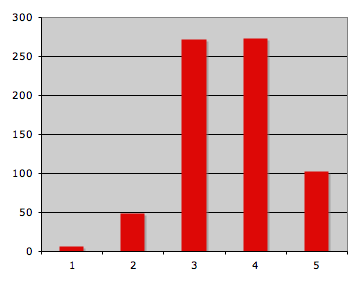
My use of the appearance scale |
- Something's really wrong with this beer. It looks watery and has no head, for example, or the body somehow looks unappetizing. This rating is pretty rare.
- I can find something negative about the beer, and there is nothing positive that stands out. The beer looks too pale and watery, or there is no head, or the head disappears too quickly, or there is no head, or...
- Standard, normal, average pilsener.
- I can find something positive about the beer, and there is nothing negative that stands out. The beer has a nice colour, the head is particularly creamy, shiny, and nicely coloured, or whatever.
- This is just an amplified version of the previous one. A good example here is Guinness, where the overall colours, the head, and the sharp line between the body and the head is just unusually beautiful.
The graph on the right shows how many beers have been rated with each of the points on the scale.
Aroma
This was the easy part. The next step is to smell the beer, and this part can be quite tricky. The goal here is to determine the components of the aroma. Usually it helps to try to distinguish the main aroma from the weaker background aromas. Really concentrating and spending a minute or two is essential here. (Getting the temperature right helps.) Sometimes you may have to search your memory for a while to recall exactly what the aroma reminds you of. Again, I write a sentence or two about this.
The next thing is to do the numeric rating, and in this case it is on a scale of 1-10, because aroma is more important. In this case the focus point for me is 4, which I use for beers where I can't pick up the aroma at all. That gives a scale like this:
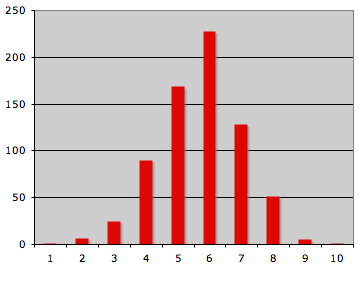
My use of the aroma scale |
- Awful. Makes you dread actually drinking the stuff.
- Definitely unpleasant.
- Not really unpleasant, but no aroma would have been an improvement.
- No aroma.
- OK, but not really good.
- Good, but nothing special.
- Really nice.
- Something special. Really a beer out of the ordinary.
- Exceptional! (Rare.)
- One in a thousand, at most.
Flavour
The next step is almost as difficult, but usually a little easier. When you taste the beer there is usually a difference between the initial taste and the aftertaste, and quite often there is a third taste that lingers after the aftertaste. This gives you three different things to analyze, and helps break it up. Determining of the beer is sweet or acidic, if it's bitter/dry in the aftertaste, etc, is also something useful to look for. It also helps to look for things like whether you can pick up the hop aroma in any way. Knowing a bit about hops is useful here.
Then there is the numeric rating (1-10), but it comes out the same as for aroma. The usual graph below.
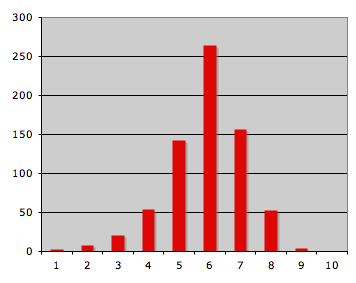
My use of the flavour scale |
Palate
This one took me a long time to figure out, but it's really just how the beer feels in the mouth. This isn't really too central to me, so I tend not to comment on it too much. I try to note, however, if the beer feels thin, or thick and chewy, and whether it feels smooth or rough, and this kind of thing. The numeric scale is 1-5, and I always start from 3, which is the rating I give to unexceptional beers. Anything positive knocks it up 1-2 points, or the same for anything negative. Sometimes I use this field to adjust the score a little, if I feel the other values didn't come out in a way that really corresponds to what I think. The usual graph below.
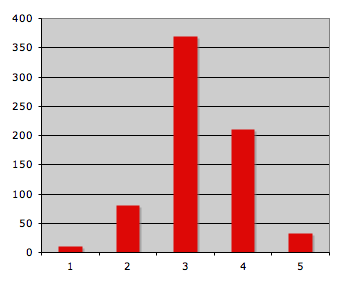
My use of the palate scale |
Overall
This is where subjectivity reigns supreme, basically. In the text I usually try to summarize what I think of the beer. The numeric rating is (1-20), and here I try to do the same, really. Usually I consider mostly how it tasted, but I don't break that up into aroma, palate, and taste, but try to just summarize the whole experience of the beer.
A scale from 1 to 20 is actually quite big, so it can be difficult to use it consistently. I use 9 as the centre, in order to get more space for the good beers, which gives me the following scale:
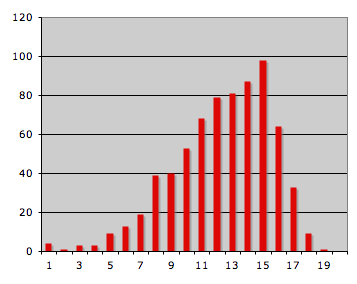
My use of the overall scale |
- Two sips, then pour the beer out, and rinse the mouth.
- Getting really unpleasant. Won't finish.
- Vaguely unpleasant. Probably won't finish the glass.
- Not good, but not really unpleasant, either.
- Nothing positive any more.
- Quite a bit of off tastes, but beer has positive aspects, too.
- Off tastes getting noticeable. Not a good beer.
- Some off tastes, but not much.
- A normal, bland pale lager with little taste and no off tastes usually goes here.
- A boring beer with some slight positive thing about it.
- Not bad, but impressive, either.
- About average for a decent beer.
- Slightly above average, but not much.
- A good beer, but not outstanding.
- A really good beer, beginning to stand out.
- A rare beer. Something special.
- Now we are really talking. This is not something I'll forget.
- Exceptional! Really, really good.
- One in a thousand, if that.
- Not used yet.
Similar posts
2K: The worst beers
Now that I've passed 2000 beers I figured it would be interesting to go back and look at which of these beers were the absolute worst beers
Read | 2008-07-01 18:41
BrewDog Paradox whisky beers
I don't usually do beer reviews on this blog, but I got "reviewer copies" of the BrewDog Paradox Smokehead and Isle of Arran, and thought they were worth writing about
Read | 2009-02-15 13:35
2K: The five best beers
I wanted to make the 2K series quite long, with various lists of beers selected by different criteria, but I never managed to find any selections that inspired me enough to actually write the pieces, so we'll round off with the obvious one instead
Read | 2008-09-07 14:19
Comments
Rob - 2006-11-01 22:16:38
Hi Lars, are you rating the beers in an absolute sense, based on your preferences? Or are you rating them relative to some style criteria? For example, haziness is generally considered a defect in appearance, but it is true to the style of a Hefeweizen. In fact Hefeweizen without a yeast haze may be considered a defect.
Lars Marius - 2006-11-01 22:30:14
Hi Rob,
That's a good question. Generally, I ignore the beer type when I do the numeric part of the rating. If I find that the beer doesn't really fit the advertised style I'll comment on it in the text, but I won't really penalize it for it, except that I may be biased by disappointment.
This would tend to mean that pale lagers, for example, have a hard time reaching the top scores, but that's life. If I enjoy pale lagers less than stouts, say, then I think the scores should reflect that.
BTW: Weizen without the yeast haze is generally called a kristallweizen. Of course, you could have a clear one and call it hefeweizen, which I guess I would consider misleading. I wouldn't lower the score because of that, though.
me - 2008-01-10 09:27:56
maybe before you rate beers, you should learn how to spell pilsner.
Lars Marius - 2008-01-10 09:32:50
"Pilsener" is German, and really means "from Pilsen", and the German name of Plzen was Pilsen, so "Pilsener" is actually the historically correct name. You'll note that Wikipedia says both forms are valid (and they're certainly both used!), but uses "Pilsener". So I think I'm okay on that score.
Cullen - 2009-08-12 03:15:27
I know it's been a while since you've posted this but I'm hoping you're still an avid beer reviewer.
I'm curious if you like the standard "Comments" field when you review a beer or if you would prefer to have it broken out so that you make a writeup under each section? (appearance, aroma, etc...) I ask because I've seen a lot of people do this on their own and some that just make a continuous paragraph.
Ben Vo - 2009-11-15 21:11:56
Hey thanks for the blog post on rating beer. I just recently started getting into new/good beer and have been wanting to do a few reviews on Ratebeer but didn't know how- now I have a bit of direction.
BTW: I prefer the pilsener spelling, my grandparents are Czech and I'm pretty sure any Czech spelling out that word in English uses Pilsener.
DigiFlex - 2010-03-26 00:17:59
Thanks for your beer rating blog. I've been a big beer drinker for a while now but haven't wanted to actually do ratings until now. I have some friends that are brewers and feel they deserve a proper rating for their creations. This blog is well written and gave me the basic knowledge that I needed. Oh, and the hater that posted on 1-10 needs to find a new hobby.